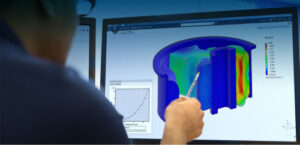The aerospace industry stands at the forefront of innovation, where precision, efficiency, and safety are paramount. As demands for lighter, faster, and more efficient aircraft continue to rise, engineers require advanced tools that enable them to meet stringent design standards while optimizing resources. SOLIDWORKS 3D CAD has emerged as a game-changing solution, empowering aerospace engineers to streamline complex design processes, reduce time-to-market, and maintain regulatory compliance.
Aerospace design involves intricate assemblies, tight tolerances, and multidisciplinary collaboration. SOLIDWORKS 3D CAD simplifies these complexities with robust part and assembly modeling features. Engineers can create highly detailed 3D models of aircraft components, from fuselage structures to turbine blades, with parametric control and intuitive interfaces. The software allows quick iterations and design changes without the need to start from scratch, significantly saving development time.
Advanced surfacing capabilities also enable the design of aerodynamic shapes essential for flight efficiency. With SOLIDWORKS, engineers can accurately simulate the curvature and contours of wings and body panels, ensuring optimal aerodynamic performance from the initial stages of product development.
In the aerospace industry, multiple teams often work on different components of the same system. SOLIDWORKS 3D CAD enhances collaboration through its single-window integration with the 3DEXPERIENCE platform. This integration ensures that all design data is centrally managed, reducing duplication and miscommunication. Engineers, designers, and suppliers can collaborate in real-time, share feedback, and make informed decisions without delays.
Features like SOLIDWORKS PDM (Product Data Management) help manage large volumes of design files, track revisions, and control access permissions—critical for projects involving sensitive or classified information. Teams can work concurrently on assemblies without overwriting changes, ensuring a streamlined workflow and enhanced productivity. Traditional aerospace prototyping is expensive and time-consuming. SOLIDWORKS 3D CAD, combined with simulation tools, allows engineers to validate designs virtually before any physical prototypes are built. Engineers can test for stress, thermal impact, vibration, and more, directly within the 3D CAD environment.
This integration drastically reduces the number of physical prototypes required, cutting costs and development time. For instance, wing structures can be tested under simulated air pressure and turbulence conditions, enabling teams to detect and rectify potential issues early in the design cycle.
Faster Regulatory Compliance and Documentation
Meeting aerospace standards such as AS9100 and FAA regulations is a critical part of product development. SOLIDWORKS 3D CAD aids in creating precise, production-ready 2D drawings and 3D annotations with Model-Based Definition (MBD). This ensures that manufacturing documentation is accurate and up-to-date, simplifying the compliance process.
With features like automated BOM generation and revision tracking, engineering teams can maintain clear records of changes and ensure that all stakeholders are aligned. The ability to generate and update documentation quickly improves responsiveness to regulatory audits and client specifications.
Accelerating Innovation in Aerospace Manufacturing
Modern aerospace manufacturing increasingly relies on digital technologies like additive manufacturing (3D printing) and CNC machining. SOLIDWORKS 3D CAD supports direct output to these technologies with tools that optimize parts for manufacturability.
Engineers can simulate the manufacturing process to identify potential challenges, such as support structure requirements or tool path inefficiencies. By designing parts specifically for additive or subtractive manufacturing, aerospace companies can minimize waste and increase production speed.
Real-World Impact: Aerospace Success Stories
Numerous aerospace companies have leveraged SOLIDWORKS 3D CAD to drive innovation. For example, Boom Supersonic, a company developing supersonic commercial aircraft, uses SOLIDWORKS to accelerate design iterations and maintain tight tolerances required for supersonic flight. Their engineering teams reported significant reductions in development time and improved collaboration across departments.
Similarly, NASA contractors and aerospace startups have adopted SOLIDWORKS to design components for satellites, drones, and spacecraft. The intuitive interface and powerful modeling capabilities make it an ideal choice for both large-scale manufacturers and agile engineering teams.
Conclusion
As aerospace engineering continues to evolve, tools like SOLIDWORKS 3D CAD play a crucial role in meeting the demands of modern aviation. By enabling precision modeling, real-time collaboration, reduced prototyping, and regulatory readiness, SOLIDWORKS empowers aerospace engineers to push the boundaries of innovation. Whether designing commercial jets or next-generation spacecraft, SOLIDWORKS provides the foundation for transforming ideas into flight-ready reality.


